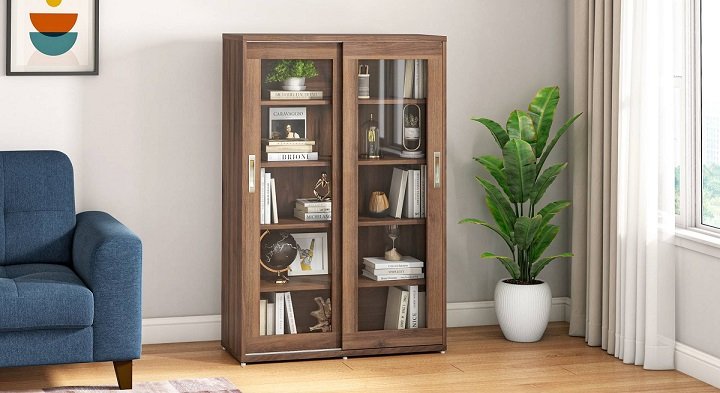Table of Contents
ToggleThe Ultimate Guide to Bookshelves: Types, Designs, Maintenance, and More
Bookshelves are not just a functional necessity for holding books; they are a key element in interior design that can enhance the aesthetic of your home, office, or library. Whether you’re an avid reader, a collector of rare editions, or someone who simply needs a place to store books and other items, the right bookshelf can make a significant difference in your living space. In this detailed guide, we will cover everything you need to know about bookshelves, from their types and materials to design ideas and maintenance tips.
If you are searching for the perfect bookshelf or simply want to learn more about how to optimize your bookshelf space, this article is for you. We will also provide insights into choosing a bookshelf that complements your décor, troubleshooting issues, and maintaining your bookshelf for long-lasting use.
What is a Bookshelf?
A bookshelf is a structure or piece of furniture designed to hold books, magazines, and sometimes decorative items. Bookshelves are found in homes, offices, libraries, and other spaces where reading materials are kept. The primary purpose of a bookshelf is to provide a safe and organized space for books while also contributing to the overall aesthetic of a room.
Bookshelf Functions and Benefits
- Storage: The primary function of a bookshelf is to provide storage for books, magazines, and other items like photos, artwork, and decorative objects.
- Organization: Bookshelves help keep books organized and accessible, especially when they are arranged by genre, size, or author.
- Space-Saving: Bookshelves are ideal for maximizing vertical space in small apartments or rooms.
- Design Element: Bookshelves come in various shapes, sizes, and styles, which can serve as a statement piece or blend seamlessly into existing décor.
Types of Bookshelves
There is no shortage of bookshelf designs, and the type you choose will depend on your space, style preferences, and storage needs. Below are the most popular types of bookshelves:
1. Wall-Mounted Bookshelves
These bookshelves are mounted directly to the wall, offering a space-saving solution for smaller rooms or apartments. They’re ideal for people who want a sleek, minimalistic design and those with limited floor space.
- Pros: Saves floor space, easy to install, ideal for small spaces.
- Cons: May not hold a lot of weight, installation may require drilling into the wall.
2. Freestanding Bookshelves
These are the most traditional type of bookshelves and are available in various shapes, sizes, and materials. They can be placed anywhere in a room and are easy to move.
- Pros: Flexible, available in many designs, no need for installation.
- Cons: Can take up valuable floor space, less stable than wall-mounted units in some cases.
3. Corner Bookshelves
Corner bookshelves are designed to fit into the corners of rooms, making them ideal for rooms with limited wall space. These bookshelves are often triangular or L-shaped, allowing you to utilize otherwise unused space.
- Pros: Saves space, utilizes corners effectively.
- Cons: May not have as much storage space as larger bookshelves.
4. Ladder Bookshelves
Ladder bookshelves have a unique design resembling a leaning ladder. They offer a stylish and modern look, usually with several tiers to store books and display decorative items.
- Pros: Trendy design, takes up less space, stylish.
- Cons: Not ideal for heavy books, limited storage space.
5. Cube Bookshelves
Cube bookshelves are modular and feature cube-shaped compartments, often offering a more modern look. They are versatile and can be rearranged to fit different spaces or purposes.
- Pros: Modular, customizable, can hold various items besides books.
- Cons: Limited space for larger books, less traditional design.
6. Open-Back Bookshelves
Open-back bookshelves have no back panel, making them ideal for displaying books in a way that gives a more open and airy feel. These are often used in minimalist or industrial décor.
- Pros: Light, airy design, easy to access books.
- Cons: Books may collect dust from behind, may not be as sturdy as closed-back bookshelves.
7. Bookcases with Doors
These bookshelves come with doors, often glass or wooden, to protect the contents from dust and to keep items secure. They’re ideal for people who want a tidier, more controlled environment.
- Pros: Keeps books and items dust-free, adds a sophisticated look.
- Cons: May require extra space for doors to open, slightly higher cost.
Materials Used in Bookshelves

Bookshelves come in a wide variety of materials, and each material has its own unique advantages and disadvantages. Here are some of the most common materials used for bookshelves:
| Material | Pros | Cons |
|---|---|---|
| Wood | Durable, classic look, can be customized in various finishes. | Expensive, heavy, requires regular maintenance. |
| Metal | Modern, durable, easy to clean, ideal for industrial or minimalist designs. | Can be heavier, may not match all home decors, tends to show scratches more. |
| Glass | Sleek and elegant, perfect for showcasing books or decorative pieces. | Fragile, can accumulate fingerprints, needs regular cleaning. |
| Plastic | Affordable, lightweight, easy to clean, available in various colors and shapes. | Less durable, may not support heavy books. |
| MDF (Medium Density Fiberboard) | Economical, available in wood-like finishes, easy to paint. | Not as durable as solid wood, can warp over time. |
| Bamboo | Eco-friendly, lightweight, strong, and durable. | Can be prone to scratches, may be more expensive than other wood options. |
| Plywood | Affordable, available in various finishes, eco-friendly when sourced sustainably. | Can show wear and tear more quickly, may not have as refined a finish as solid wood. |
Design Ideas for Bookshelves
When choosing the design of your bookshelf, you should think about the overall aesthetic of the room and how the bookshelf will function. Here are some design ideas:
1. Minimalist Bookshelves
If you’re going for a modern and uncluttered look, minimalist bookshelves are the way to go. These typically feature clean lines, open shelving, and a focus on simplicity.
2. Floating Bookshelves
Floating bookshelves offer a sleek look without any visible hardware. The shelves appear to “float” on the wall, providing a modern, cutting-edge aesthetic.
3. Vintage or Rustic Bookshelves
For a more nostalgic feel, vintage or rustic bookshelves made of reclaimed wood or distressed finishes can bring warmth and character to any space.
4. Geometric Bookshelves
Geometric-shaped bookshelves are popular for adding an element of design to a room. With sharp angles or circular shelves, they create a dynamic and eye-catching display for books.
5. Built-In Bookshelves
For a more permanent solution, built-in bookshelves are custom-designed to fit the space in a room. They offer a sleek and seamless look and can even be part of a wall feature, such as an entertainment unit.
How to Organize Your Bookshelf
Organizing a bookshelf may seem like a daunting task, but there are various strategies to keep your books neat and accessible. Here are some organization ideas:
- Alphabetical Order: Arrange your books alphabetically by author or title. This is particularly useful for larger collections of books.
- By Genre: Organize your books by category, such as fiction, non-fiction, fantasy, mystery, etc. This is ideal for readers who prefer genre-based sorting.
- By Color: For a more aesthetic approach, organize books by color. This creates a visually pleasing rainbow effect.
- By Size: For a symmetrical and organized look, arrange books by size. Larger books should go on the bottom, with smaller books on top.
- By Frequency of Use: Keep the most frequently read books at eye level and less frequently used books on the higher or lower shelves.
Maintaining Your Bookshelf
To keep your bookshelf looking beautiful and functional for years to come, regular maintenance is essential. Here are some tips:
- Dust Regularly: Dust accumulates on both books and shelves, so it’s important to wipe them down regularly with a soft, microfiber cloth.
- Avoid Direct Sunlight: Prolonged exposure to sunlight can cause books to fade and materials like wood or metal to deteriorate over time.
- Check for Structural Integrity: Periodically check for loose screws, sagging shelves, or any other structural issues. Tighten screws or make adjustments as needed.
- Use Bookends: To prevent books from toppling over, consider using bookends to keep books upright and organized.
- Clean the Shelves: Depending on the material of your bookshelf, clean the shelves according to manufacturer guidelines. Use appropriate cleaners for wood, glass, or metal.
Conclusion
Bookshelves are an essential piece of furniture in every home, offering not only a practical solution for storing books but also enhancing the design and aesthetic of any room. From traditional wooden bookshelves to sleek, modern designs, there is a bookshelf for every taste and space.
By considering the various types, materials, and design ideas mentioned in this guide, you can make an informed decision when purchasing or designing your bookshelf. Additionally, organizing and maintaining your bookshelf will ensure that it remains both functional and visually appealing for years to come.
We hope this guide has provided valuable insights into the world of bookshelves, helping you create the perfect setup for your home or office.
Disclaimer: This article provides general information about bookshelves, their designs, and maintenance. While every effort has been made to ensure accuracy, readers should verify specific product details and recommendations with manufacturers or furniture specialists. All advice in this article is based on general principles and may not apply to every individual situation.
